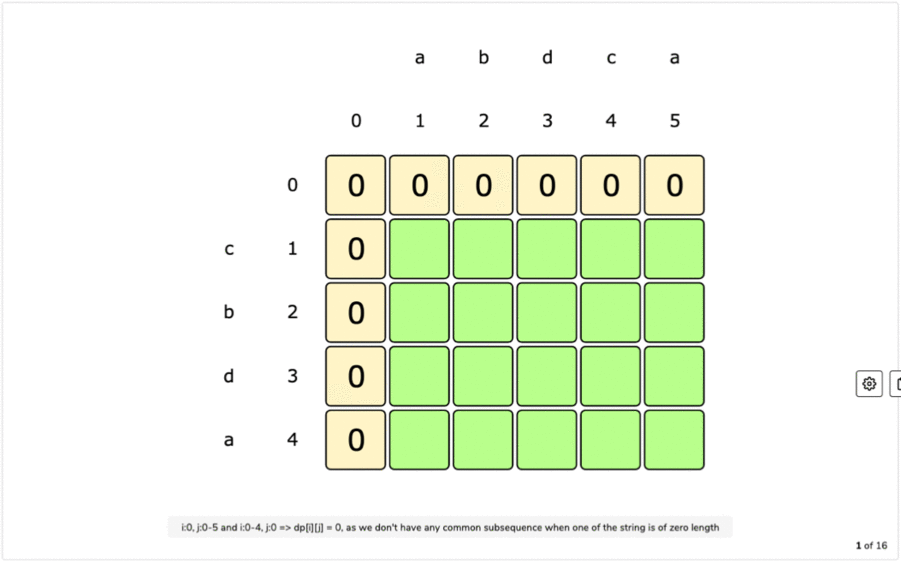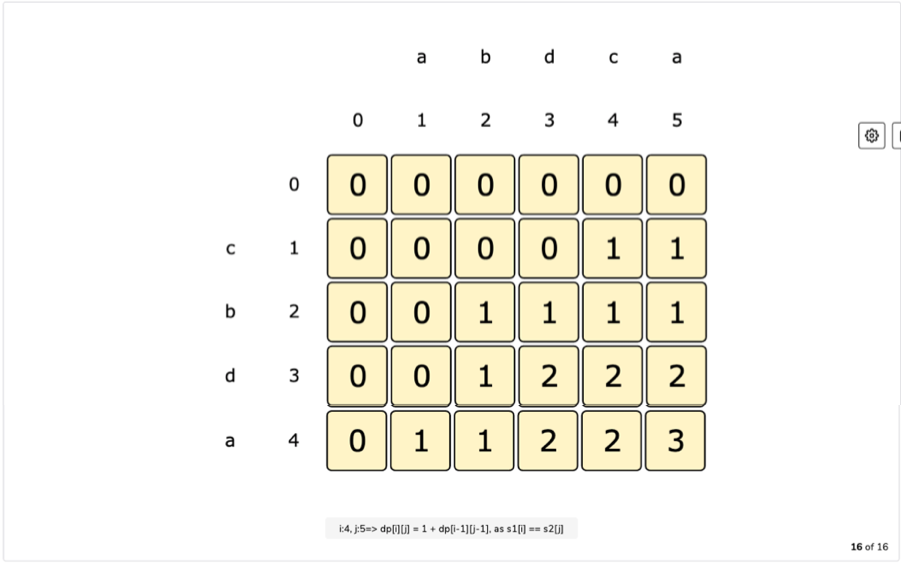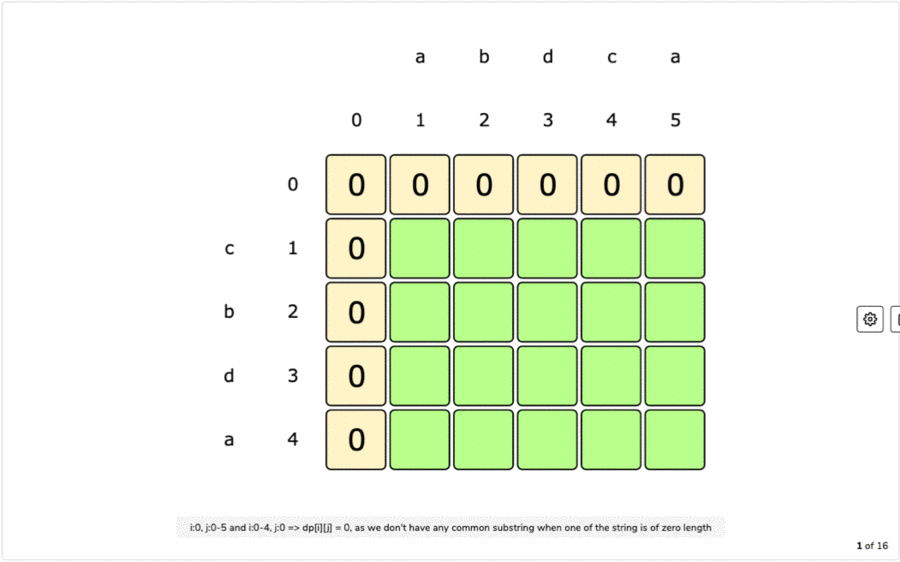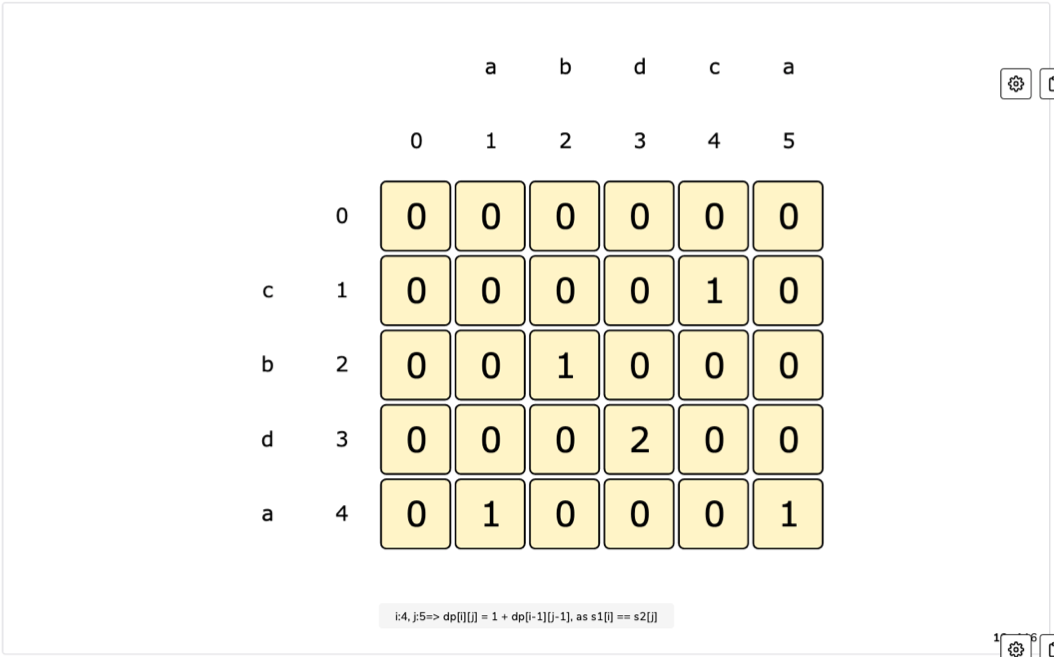Longest Common Subsequence Pattern
Problems Following Longest Common Subsequence Pattern
1. Longest Common Subsequence
Problem Statement:
Given two strings str1 and str2 find the length of the longest common subsequence in both the strings.
A subsequence is a sequence that can be derived from another sequence by deleting some or no elements without changing order.
===== Examples =====
Input: str1 = "abdca", str2 = "cbda"
Output: 2
Explanation: The longest common substring is "bd"
Input: str1 = "passport", str2 = "ppsspt"
Output: 5
Explanation: The longest common substring is "psspt"
Brute-Force : Recursive Solution
- A basic brute-force solution could be to try all subsequences of str1 and str2 to find the longest one.
- We can match both the strings one character at a time.
- For every index i in str1 and j in str2, we must choose between:
- If the character str1[i] and str2[j] matches, we can recursively match for remaining lengths.
- If the character str1[i] and str2[j] doesn’t match, start two recursive calls by skipping one character separately from each string.
Code:
def find_longest_common_subsequence_recursion(str1, str2):
i, j = 0, 0
return find_longest_common_subsequence_recursion_util(str1, str2, i, j)
def find_longest_common_subsequence_recursion_util(str1, str2, i, j):
if (i == len(str1) or j == len(str2)):
return 0
if (str1[i] == str2[j]):
return 1 + find_longest_common_subsequence_recursion_util(str1, str2, i + 1, j + 1)
skip_1st_count = find_longest_common_subsequence_recursion_util(str1, str2, i + 1, j)
skip_2nd_count = find_longest_common_subsequence_recursion_util(str1, str2, i, j + 1)
return max(skip_1st_count, skip_2nd_count)
print("Recursive Method :")
print(find_longest_common_subsequence_recursion("abdbca", "cbda"))
print(find_longest_common_subsequence_recursion("passport", "ppsspt"))
Output:
Recursive Method :
3
5
Complexity:
- Time: O(2m+n) - Here m and n are lengths of two substrings and we have 2 recursive calls in worse cases when character not matches.
- Space: O(m+n) - Used to store the recursion stack.
DP : Recursion + Memoization (Top-Down) Solution
- We can use memoizaton to solve the recurring problem.
- The two changing values in our recursive function is two start indexes i, j.
- We can use 2-D array to store solution to our repeated subproblems.
- We can also use i + “|” + j as key to store in a hashmap.
Code:
def find_longest_common_subsequence_dp_memoization(str1, str2):
i, j = 0, 0
n1, n2 = len(str1), len(str2)
memory = [[None]*(n2) for _ in range(n1)]
return find_longest_common_subsequence_dp_memoization_util(str1, str2, i, j, memory)
def find_longest_common_subsequence_dp_memoization_util(str1, str2, i, j, memory):
if (i == len(str1) or j == len(str2)):
return 0
if (memory[i][j]):
return memory[i][j]
if (str1[i] == str2[j]):
memory[i][j] = 1 + find_longest_common_subsequence_dp_memoization_util(str1, str2, i + 1, j + 1, memory)
return memory[i][j]
skip_1st_count = find_longest_common_subsequence_dp_memoization_util(str1, str2, i + 1, j, memory)
skip_2nd_count = find_longest_common_subsequence_dp_memoization_util(str1, str2, i, j + 1, memory)
memory[i][j] = max(skip_1st_count, skip_2nd_count)
return memory[i][j]
print("\nDP -> Recursion + Memoization Method :")
print(find_longest_common_subsequence_dp_memoization("abdbca", "cbda"))
print(find_longest_common_subsequence_dp_memoization("passport", "ppsspt"))
Output:
DP -> Recursion + Memoization Method :
3
5
Complexity:
- Time: O(mn) - Here m and n are lengths of two substrings and at max we can have m*n subproblems.
- Space: O(mn) - Need to store total of m*n subproblems result.
DP : Iteration + Tabulation (Bottom-Up) Solution
- Since we want to match all the subsequences of the given two strings, we can use a 2-D array to store our results.
- Lengths of the two strings will define the size of the 2-D array.
- For every index i in string str1 and j in string str2, we have two options:
- If the character at str1[i] and str2[j] matches, the count will be 1 + length of common substring till i-1 and j-1 indexes.
- If the charactre at str1[i] and str2[j] doesn’t match, we will take max of sequences by skipping either first or last.
Table Filling Formula:
if(str1[i] == str2[j]):
table[i][j] = 1 + table[i-1][j-1]
else:
table[i][j] = max(table[i-1][j], table[i][j-1])
Tabulation:

Final Table:

Code:
def find_longest_common_subsequence_dp_tabulation(str1, str2):
n1, n2 = len(str1), len(str2)
table = [[0] * (n2 + 1) for _ in range(n1 + 1)]
for i in range(1, n1 + 1):
for j in range(1, n2 + 1):
if (str1[i - 1] == str2[j - 1]):
table[i][j] = 1 + table[i-1][j-1]
else:
table[i][j] = max(table[i - 1][j], table[i][j - 1])
return table[i][j]
print("\nDP -> Iteration + Tabulation Method :")
print(find_longest_common_subsequence_dp_tabulation("abdbca", "cbda"))
print(find_longest_common_subsequence_dp_tabulation("passport", "ppsspt"))
Output:
DP -> Iteration + Tabulation Method :
3
5
Complexity:
- Time: O(mn) - Here m and n are lengths of two substrings and at max we can have m*n subproblems.
- Space: O(mn) - Need to store total of m*n subproblems result.
DP : Iteration + Tabulation (Bottom-Up) Space Optimized Solution
- If we watch closely
table[i][j] = 1 + table[i - 1][j - 1]** or **max(table[i - 1][j], table[i][j - 1]), to calcualate value for any box we only need the previous row value. - So, we will take only two rows and will alternate b/w them for previous rows using %2.
Code:
def find_longest_common_subsequence_dp_tabulation_space_optimized(str1, str2):
n1, n2 = len(str1), len(str2)
table = [[0] * (n2 + 1) for _ in range(2)]
for i in range(1, n1 + 1):
for j in range(1, n2 + 1):
if (str1[i - 1] == str2[j - 1]):
table[i % 2][j] = 1 + table[(i - 1) % 2][j - 1]
else:
table[i % 2][j] = max(table[(i - 1) % 2][j], table[i % 2][j - 1])
return table[i % 2][j]
print("\nDP -> Iteration + Tabulation Space Optimized Method :")
print(find_longest_common_subsequence_dp_tabulation_space_optimized("abdbca", "cbda"))
print(find_longest_common_subsequence_dp_tabulation_space_optimized("passport", "ppsspt"))
Output:
DP -> Iteration + Tabulation Space Optimized Method :
3
5
Complexity:
- Time: O(mn) - Here m and n are lengths of two substrings and at max we can have m*n subproblems.
- Space: O(n) - Need to store total of of 2 rows data only so it is 2n ≈ O(n).
2. Longest Common Substring (LCS)
Problem Statement:
Given two string str1 and str2, find the length of longest substring which is common in both the strings.
===== Examples =====
Input: str1 = "abdca", str2 = "cbda"
Output: 2
Explanation: The longest common substring is "bd"
Input: str1 = "passport", str2 = "psspt"
Output: 3
Explanation: The longest common substring is "ssp"
Brute-Force : Recursive Solution
- A basic brute force solution is to try all substring of str1 and str2 to find the longest common one.
- We can start matching both the strings one character at a time, we have 2 options at any step:
- If strings have matching character, recursively match for remaining lenghts and keep the current matching length.
- If strings don’t match, start 2 new recursive calls by skipping 1 character separately from each string and reset matching length.
- The maximum LCS length will be max returned by all 3 recursive calls.
Code:
def find_lcs_length_recursion(str1, str2):
i, j, lcs_length = 0, 0, 0
return find_lcs_length_recursion_util(str1, str2, i, j, lcs_length)
def find_lcs_length_recursion_util(str1, str2, i, j, lcs_length):
if (i == len(str1) or j == len(str2)):
return lcs_length
lcs_length_1 = lcs_length
if (str1[i] == str2[j]):
lcs_length_1 = find_lcs_length_recursion_util(str1, str2, i + 1, j + 1, lcs_length + 1)
lcs_length_2 = find_lcs_length_recursion_util(str1, str2, i, j + 1, 0)
lcs_length_3 = find_lcs_length_recursion_util(str1, str2, i + 1, j, 0)
return max(lcs_length_1, lcs_length_2, lcs_length_3)
print("Recursive Method :")
print(find_lcs_length_recursion("abdbca", "cbda"))
print(find_lcs_length_recursion("passport", "psspt"))
Output:
Recursive Method :
2
3
Complexity:
- Time: O(3m+n) - Here m and n are lengths of two substrings and we have 3 recursive calls.
- Space: O(m+n) - Used to store the recursion stack.
DP : Recursion + Memoization (Top-Down) Solution
- We can use memoizaton to solve the recurring problem.
- The three changing values in our recursive function is two start indexes i, j and lcs_length.
- We can use 3-D array to store solution to our repeated subproblems.
- We can also use i + “|” + j + “|” + lcs_length as key to store in a hashmap.
Code:
def find_lcs_length_dp_memoization(str1, str2):
n1, n2 = len(str1), len(str2)
max_lcs_length = min(n1, n2)
memory = [[[None] * max_lcs_length for _ in range(n2)] for _ in range(n1)]
i, j, lcs_length = 0, 0, 0
return find_lcs_length_dp_memoization_util(str1, str2, i, j, lcs_length, memory)
def find_lcs_length_dp_memoization_util(str1, str2, i, j, lcs_length, memory):
if (i == len(str1) or j == len(str2)):
return lcs_length
if (memory[i][j][lcs_length]):
return memory[i][j][lcs_length]
lcs_length_1 = lcs_length
if (str1[i] == str2[j]):
lcs_length_1 = find_lcs_length_dp_memoization_util(str1, str2, i + 1, j + 1, lcs_length + 1, memory)
lcs_length_2 = find_lcs_length_dp_memoization_util(str1, str2, i, j + 1, 0, memory)
lcs_length_3 = find_lcs_length_dp_memoization_util(str1, str2, i + 1, j, 0, memory)
memory[i][j][lcs_length] = max(lcs_length_1, lcs_length_2, lcs_length_3)
return memory[i][j][lcs_length]
print("\nDP -> Recursion + Memoization Method :")
print(find_lcs_length_dp_memoization("abdbca", "cbda"))
print(find_lcs_length_dp_memoization("passport", "psspt"))
Output:
DP -> Recursion + Memoization Method :
2
3
Complexity:
- Time: O(mn*min(m, n)) - Here m and n are lengths of two substrings and at max we can have m*n*min(m, n) subproblems.
- Space: O(mn*min(m, n)) - Need to store total of m*n*min(m, n) subproblems result.
DP : Iteration + Tabulation (Bottom-Up) Solution
- Since we want to match all the substring of the given two strings, we can use a 2-D array to store our results.
- Lengths of the two strings will define the size of the 2-D array.
- For every index i in string str1 and j in string str2, we have two options:
- If the character at str1[i] and str2[j] matches, the lcs_length will be 1 + length of common substring till i-1 and j-1 indexes.
- If the charactre at str1[i] and str2[j] doesn’t match, we don’t have any common substring.
Table Filling Formula:
if(str1[i] == str2[j]):
table[i][j] = 1 + table[i-1][j-1]
else:
table[i][j] = 0
Tabulation:

Final Table:

Here we can see that longest common substring is of length 2, represented by table[3][3].
Code:
def find_lcs_length_dp_tabulation(str1, str2):
n1, n2 = len(str1), len(str2)
table = [[0] * (n2 + 1) for _ in range(n1 + 1)]
lcs_length = 0
for i in range(1, n1 + 1):
for j in range(1, n2 + 1):
if (str1[i - 1] == str2[j - 1]):
table[i][j] = 1 + table[i - 1][j - 1]
lcs_length = max(lcs_length, table[i][j])
else:
table[i][j] = 0
return lcs_length
print("\nDP -> Iteration + Tabulation Method :")
print(find_lcs_length_dp_tabulation("abdbca", "cbda"))
print(find_lcs_length_dp_tabulation("passport", "psspt"))
Output:
DP -> Iteration + Tabulation Method :
2
3
Complexity:
- Time: O(mn) - Here m and n are lengths of two substrings and at max we can have m*n subproblems.
- Space: O(mn) - Need to store total of m*n subproblems result.
DP : Iteration + Tabulation (Bottom-Up) Space Optimized Solution
- If we watch closely **
table[i][j] = 1 + table[i - 1][j - 1]** , to calcualate value for any box we only need the previous row value. - So, we will take only two rows and will alternate b/w them for previous rows using %2.
Code:
def find_lcs_length_dp_tabulation_space_optimized(str1, str2):
n1, n2 = len(str1), len(str2)
table = [[0] * (n2 + 1) for _ in range(2)]
lcs_length = 0
for i in range(1, n1 + 1):
for j in range(1, n2 + 1):
if (str1[i - 1] == str2[j - 1]):
table[i % 2][j] = 1 + table[(i - 1) % 2][j - 1]
lcs_length = max(lcs_length, table[i % 2][j])
else:
table[i % 2][j] = 0
return lcs_length
print("\nDP -> Iteration + Tabulation Space Optimized Method :")
print(find_lcs_length_dp_tabulation_space_optimized("abdbca", "cbda"))
print(find_lcs_length_dp_tabulation_space_optimized("passport", "psspt"))
Output:
DP -> Iteration + Tabulation Space Optimized Method :
2
3
Complexity:
- Time: O(mn) - Here m and n are lengths of two substrings and at max we can have m*n subproblems.
- Space: O(n) - Need to store total of of 2 rows data only so it is 2n ≈ O(n).
3. Minimum Deletions & Insertions to Transform a String into another
Problem Statement:
Given string str1 and str2, we need to transform str1 into str2 by deleting and inserting characters.
Calculate the count of the minimum number of deletion and insertion operations.
====== Examples ======
Input: str1 = "abc", str2 = "fbc"
Output: 1 deletion and 1 insertion
Explanation: We need to delete {'a'} from str1 and insert {'f'} into it to transform to str2
Input: str1 = "abdca", str2 = "cbda"
Output: 2 deletions and 1 insertion
Explanation: We need to delete {'a', 'c'} from str1 and insert {'c'} into it to transform to str2
Input: str1 = "passport", str2 = "ppsspt"
Output: 3 deletions and 1 insertion
Explanation: We need to delete {'a', 'o', 'r'} from str1 and insert {'p'} into it to transform to str2
Solution Approach:
- The problem is very similar to finding Longest Common Subsequence.
- First find the longest common subsequence lcs_count.
- Delete other characters from str1 to get the number of deletions i.e. len(str1) - lcs_count.
- Insert remaining characters from str2 to get number of insertions i.e, len(str2) - lcs_count.
- We will directly solve this problem using bottom-up tabulation approach.
DP : Iteration + Tabulation (Bottom-Up) Solution
- We will follow the process similar to of calculationg longest subsequence.
def min_delete_insert_to_transform(str1, str2):
n1, n2 = len(str1), len(str2)
table = [[0] * (n2 + 1) for _ in range(2)]
for i in range(1, n1 + 1):
for j in range(1, n2 + 1):
if (str1[i - 1] == str2[j - 1]):
table[i % 2][j] = 1 + table[(i - 1) % 2][j - 1]
else:
table[i % 2][j] = max(table[(i - 1) % 2][j], table[i % 2][j - 1])
lcs_count = table[i % 2][j]
print(f"Minimum Deletions Needed : {len(str1)-lcs_count}")
print(f"Minimum Insertions Needed : {len(str2)-lcs_count}\n")
print("DP -> Iteration + Tabulation Space Optimized Method :")
min_delete_insert_to_transform("abc", "fbc")
min_delete_insert_to_transform("abdca", "cbda")
min_delete_insert_to_transform("passport", "ppsspt")
Output:
DP -> Iteration + Tabulation Space Optimized Method :
Minimum Deletions Needed : 1
Minimum Insertions Needed : 1
Minimum Deletions Needed : 2
Minimum Insertions Needed : 1
Minimum Deletions Needed : 3
Minimum Insertions Needed : 1
Complexity:
- Time: O(mn) - Here m and n are lengths of two substrings and at max we can have m*n subproblems.
- Space: O(n) - Need to store total of of 2 rows data only so it is 2n ≈ O(n).
4. Shortest Common Super-sequence
5. Longest Repeating Subsequence
6. Subsequence Pattern Matching
7.Edit Distance
8. Strings Interleaving
← Previous: Palindromic Subsequence Pattern
Next: Longest Increasing Subsequence Pattern →